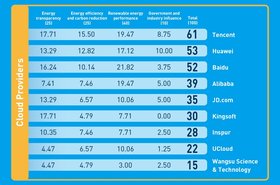Hopes of a green revolution in China's data center sector have had a setback. A report from Greenpeace predicts that far from reducing their energy use, China's data centers are likely to use four times as much electricity by 2035, with emissions doubling.
Electricity use by data centers and 5G base stations in China will grow by an estimated 289 percent between 2020 and 2035, according the Greenpeace East Asia study. That growth will produce a lot of carbon emissions, as 61 percent of its present electricity generation from coal. The country has a plan to decarbonize by 2060, its emissions will peak in 2030: emissions from the data center industry will continue growing long after this.
Could it be different?
“Explosive growth in digital infrastructure does not need to mean growth in emissions,” said Greenpeace East Asia climate and energy campaigner Ye Ruiqi. "Technology companies have the potential to catalyze real emissions reductions via investment in distributed renewables projects and direct purchase of wind and solar energy, among other strategies. But some of the industry’s biggest players, including Alibaba and GDS, have yet to issue 100 percent renewable energy or carbon neutrality commitments."
The report follows a damning edition of Greenpeace's annual Clean Cloud report for China in April, which criticized China's cloud and data center operators for their addiction to coal-fired power and lack of enthusiasm for renewable energy. Unlike their Western counterparts, only one Chinese company (Chindata) has promised to achieve carbon neutrality, while the Chinese cloud companies who spoke to Greenpeqace currently have a tiny usage of renewable power: only two reported more than three percent renewable energy usage.
Since that report, AtHub has also promised to go carbon-neutral.
Carbon emissions from China’s Internet industry will continue to rise at least until 2035, long after China’s targeted 2030 national emissions peak, creating complications for the country’s national carbon neutrality commitments, warns the report. In 2035, China's digital infrastructure will emit 310 million tonnes of carbon, which is more than three times Guangzhou’s total carbon emissions in 2019.
Sectors such steel, and cement, are due to peak in emissions at 2025. Given that these sectors handle raw materials processes which directly emit carbon, this achievement might shame Chinese digital companies into action.
5G is growing fast, and its power consumption in China will grow roughly five-fold by 2035 to 297 billion kWh, which is roughly the same as Sichuan’s total electricity consumption in 2020.
“Internet companies in China must commit to achieve 100 percent renewable energy and carbon neutrality across the supply chain by 2030. At the same time, policymakers can help enable this transition by mandating the use of 100 percent renewable energy and providing financial incentives for companies to shift to wind and solar. Digital technology should be a solution to the climate crisis, not a growing source of emissions,” said Ye.
The country is also moving to block cryptocurrency mining, which primarily runs on coal power.




